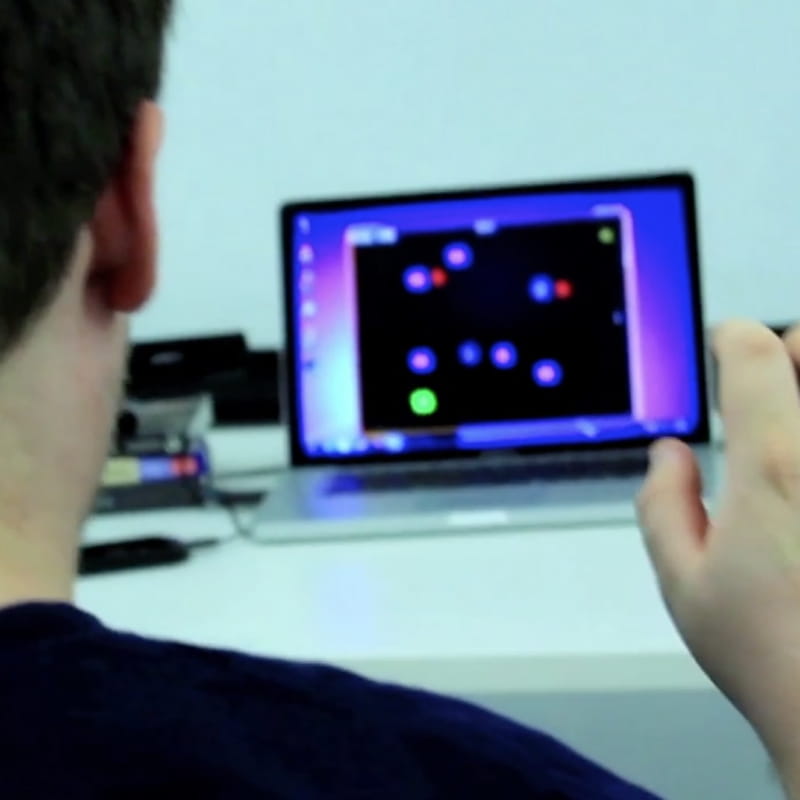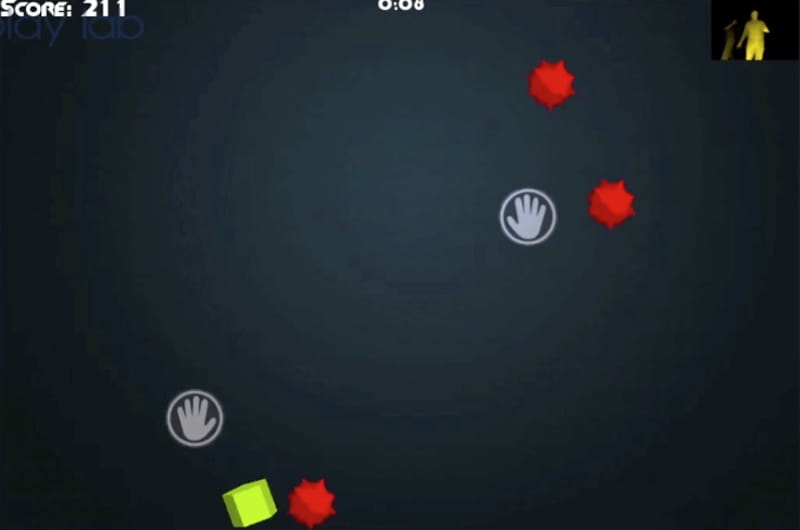Video Game Therapy — Drexel Professors Design Games For Cerebral Palsy Patients

- Drexel Selects New, World-Class Life Sciences Building at 3201 Cuthbert Street for Medical Research Operations
- Breakthrough on Gene Therapy for Hereditary Spastic Paraplegia
- Drexel Environmental Collaboratory Releases Cross-Sector Findings on Severe Weather Recovery Challenges
- Drexel Launches the Manuel Stamatakis Center for Alternative Investments at the LeBow College of Business

Using Microsoft's Kinect motion sensor platform, the Drexel team has developed a series of games that can be used as tools for physical therapy.
While video games have often been saddled with the reputation of promoting a sedentary lifestyle, a group of Drexel University professors see the digital diversions as a way of helping patients with cerebral palsy to keep on moving.
The professors, with expertise ranging from game design to movement science, physical therapy and biomedical engineering, recently formed a startup company called enAble Games, with the goal of making web-based active video games that can be used as part of therapy or rehabilitation exercise sessions.
Get Moving
Children with cerebral palsy often experience decreased physical activity, motor skills and functional mobility. One of the main physical therapy goals for CP patients, according to Margaret O’Neil, PhD, an associate professor in the Department of Physical Therapy and Rehabilitation Sciences in Drexel’s College of Nursing and Health Professions who is one of enAble’s co-founders, is to keep them physically active in order to build physical stamina, strength and range of motion.
“As they age, children and youth should participate in longer periods of activity. The national physical activity guidelines recommend at least 60 minutes of moderate to vigorous physical activity daily,” O’Neil said. “Unfortunately, most youth show trends toward decreased physical activity and increased sedentary behavior as they enter adolescence. This trend is even more pronounced in children and youth with disabilities including CP. Therefore it is critical to identify or design activities for youth to increase the amount of time in physical activity and the intensity of the activity for a health benefit.”
[iframe src="https://player.vimeo.com/video/63972578" width="500" height="281" frameborder="0" webkitallowfullscreen mozallowfullscreen allowfullscreen></iframe>
<p><a href="https://vimeo.com/63972578">Kollect Trailer - Spring/Summer 2013</a>.</p>]
To make a game that promotes physical activity, the team is availing itself of Microsoft’s Kinect technology. The system, which has been part of Microsoft’s Xbox gaming platforms since 2010, uses a series of motion sensing input devices –rather than a handheld controller – to let the user interact with the game through gestures and movements.
O’Neil, a licensed physical therapist, had previously used Kinect games as part of her research on physical activity in youth with cerebral palsy — but saw limitations in the games that existed at the time. But with co-founder Paul Diefenbach, PhD, founder of Drexel’s nationally ranked game design program in the Westphal College of Media Arts & Design; and with Robert Gray, former associate director of Drexel’s Entrepreneurial Game Studio; enAble Games is making games that are tailored to the abilities of patients with CP.
Ready, Set, Play
The first of their games, called “Kollect,” looks a bit like the popular mobile game “Fruit Ninja” but with a reappearance of those pesky explosives from the 1980s computer classic “Minesweeper.” The player operates two hand icons (with the option of using two foot icons too) in a virtual environment with the goal of collecting floating objects that are arranged throughout the game environment, while dodging the spiked, red mines.
“While this game is not overly complex visually, due to perceptual and cognitive challenges of many of the players, the underlying architecture was designed to address both the needs of the players and their physical therapists” Diefenbach said. “We created a very elegant design that is user-appropriate and extremely versatile in adapting to the individual’s physical and cognitive abilities as well as the therapeutic goals.”
In addition to the standard geometric shapes, the game has several other themes—including sports, pets, fruit, space, cowboys, spooky, vehicles and fantasy—to appeal to a variety of players. The team is also developing a series of other games that will use similar strategies for promoting physical activity.
“Our goal is to make this something fun that they look forward to doing and that they will do,” O’Neil said. “This is a great way to meet these kids where they are and push them to do a bit more. The earlier you can get them engaged, building strength, endurance and confidence, the better chance they have of adopting an active, healthy lifestyle so they can continue to walk until later in life and for longer distances. And for wheelchair users, increasing activity in and out of the chair will help improve overall health and function too. The key is to improve function so youth will increase health and participation.”
Bonus Points
Flexibility of the gaming parameters is essential, according to O’Neil, who worked with the enAble Games team members including Hasan Ayaz, PhD, an associate research professor in Drexel’s School of Biomedical Engineering, Science and Health Systems; and Patricia Shewokis, PhD, a professor who shares appointments in the College of Nursing and Health Professions, as well as the School of Biomedical Engineering and the College of Medicine’s Department of Surgery, to design games and measures of game performance to enhance physical activity and fitness to achieve physical therapy goals within the game environment.
“While CP is the most common physical disability of childhood,” O’Neil said. “It is a diagnosis that describes a rather broad group of neurodevelopmental disorders, including posture and movement disorders that cause activity limitations. For the game to be an effective form of therapy it must be adjustable to a variety of patients.”
Fortunately, the designers have built plenty of customizability into the game. Everything—from the placement of the mines, to the number and spacing of the cubes to the length of gameplay—can be changed by the physical therapist to adapt the game parameters and game difficulty so the patient can achieve the therapy goals.

“Any therapy that’s going to be effective has to be highly customized to consider each patient’s abilities and limitations,” O’Neil said. “If they can’t perform the task, or its too physically taxing, they’re not going to want to do it. The most effective physical therapy rehabilitation exercises are the ones that patients want to do, but that still challenge them --so that they have improved health outcomes. If they’re being active and having fun playing a game, and are also getting a health benefit from the activity, that’s a win.”
The game’s customizability allows the patient to play for varying lengths of time and at different levels of intensity. The goal of this is to meet the child’s ability and challenge them to improve their health and fitness, while also having a sense of success and achievement by advancing from level to level in the game.
“We want to make sure the players are meeting the challenge, rather than quitting the game because it is too difficult,” O’Neil said. “Experiencing success and building confidence is just as important as the physical goals we set in therapy.”
Next Level
Performance metrics built into the game allow physical therapists to see how long their patients have been playing and how successful they are at reaching their therapy goals. The web-based game also allows for remote access, so a physical therapist could adjust the setting of the game and monitor their patients’ progress between office visits.
“Because our games are all web-based and the only equipment needed is a laptop and a Kinect sensor, it’s easy to set up demonstrations at clinics and it will be just as easy for patients to play the games at home, as part of an exercise program which will augment the clinical therapy sessions,” O’Neil said. “The web-based element also allows the physical therapist to remotely monitor the game play and progress toward therapy goals.”
The group has been developing its games with support from the Coulter-Drexel Translational Research Partnership Program and a grant from Drexel’s Expressive and Creative Interaction Technologies (ExCITe) Center. And it was able to launch enAble in the fall of 2015 with help from an angel investor, funding from Ben Franklin Technology Partners of Southeast Pennsylvania and under the guidance of the entrepreneurship accelerator program at Innovation Center @3401.
The researchers are currently gathering user feedback from partner clinics along the East Coast, and from a cohort of more than a dozen school-age subjects who are coming to Drexel to play the game over several months. This data will guide the design of a suite of games or users with a variety of interests and ability levels.
“Once we can positively show that our active video games can promote increased physical activity for patients with cerebral palsy, we’d like to work an adapting games for other patients who could also benefit from this unique way to increase fitness, mobility and stay physically active.”
In This Article
Contact
Drexel News is produced by
University Marketing and Communications.